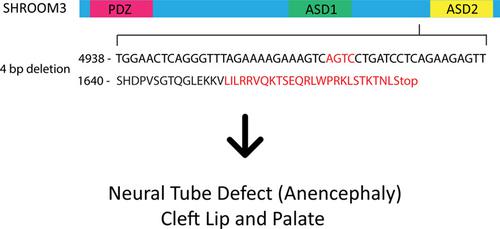当前位置:
X-MOL 学术
›
Clin. Genet.
›
论文详情
Our official English website, www.x-mol.net, welcomes your feedback! (Note: you will need to create a separate account there.)
A homozygous pathogenic variant in SHROOM3 associated with anencephaly and cleft lip and palate.
Clinical Genetics ( IF 3.5 ) Pub Date : 2020-07-03 , DOI: 10.1111/cge.13804 Ashish R Deshwar 1 , Nicole Martin 2 , Patrick Shannon 3 , David Chitayat 1, 2
Clinical Genetics ( IF 3.5 ) Pub Date : 2020-07-03 , DOI: 10.1111/cge.13804 Ashish R Deshwar 1 , Nicole Martin 2 , Patrick Shannon 3 , David Chitayat 1, 2
Affiliation

|
Neural tube defects (NTD) are among the most common congenital anomalies, affecting about 1:1000 births. In most cases, the etiology of NTD is multifactorial and the genetic variants associated with them remain largely unknown. There is extensive evidence from animal models over the past two decades implicating SHROOM3 in neural tube formation; however, its exact role in human disease has remained elusive. In this report, we present the first case of a human fetus with a homozygous loss of function variant in SHROOM3. The fetus presents with anencephaly and cleft lip and palate, similar to previously described Shroom3 mouse mutants and is suggestive of a novel monogenic cause of NTD. Our case provides clarification on the contribution of SHROOM3 to human development after decades of model organism research.
中文翻译:

SHROOM3中的纯合致病变异,与无脑,唇left裂有关。
神经管缺损(NTD)是最常见的先天性异常,影响大约1:1000的出生。在大多数情况下,NTD的病因是多因素的,与它们相关的遗传变异仍然很大程度上未知。在过去的二十年中,有大量的动物模型证据表明SHROOM3参与了神经管的形成。然而,其在人类疾病中的确切作用仍然难以捉摸。在本报告中,我们介绍了第一例人类胎儿在SHROOM3中发生功能变异纯合子的情况。胎儿表现为无脑,唇裂和pa裂,类似于先前描述的Shroom3小鼠突变体,暗示了NTD的新型单基因病因。我们的案例澄清了SHROOM3的贡献 经过数十年的模型有机体研究,对人类发展具有重要意义
更新日期:2020-08-27
中文翻译:

SHROOM3中的纯合致病变异,与无脑,唇left裂有关。
神经管缺损(NTD)是最常见的先天性异常,影响大约1:1000的出生。在大多数情况下,NTD的病因是多因素的,与它们相关的遗传变异仍然很大程度上未知。在过去的二十年中,有大量的动物模型证据表明SHROOM3参与了神经管的形成。然而,其在人类疾病中的确切作用仍然难以捉摸。在本报告中,我们介绍了第一例人类胎儿在SHROOM3中发生功能变异纯合子的情况。胎儿表现为无脑,唇裂和pa裂,类似于先前描述的Shroom3小鼠突变体,暗示了NTD的新型单基因病因。我们的案例澄清了SHROOM3的贡献 经过数十年的模型有机体研究,对人类发展具有重要意义



























 京公网安备 11010802027423号
京公网安备 11010802027423号